

 | Fluid Dynamics & Materials Processing |  |
DOI: 10.32604/fdmp.2022.019746
ARTICLE
Experimental Study on the Effect of the Inclination Angle on the Scouring Efficiency of Submerged Water Jets
1Dalian Maritime University, Naval Architecture and Ocean Engineering College, Dalian, 116026, China
2Guangzhou Maritime University, Guangzhou, 510725, China
3Key Laboratory of Road Construction & Equipment of MOE, Chang’an University, Xi’an, 710064, China
4Huiyong Holding Group Co., Ltd., Beijing, 100093, China
*Corresponding Author: Yongjun Gong. Email: gyj@dlmu.edu.cn
Received: 10 September 2021; Accepted: 21 March 2022
Abstract: The effects of oblique submerged scouring jets on sand beds with various particle sizes have been studied experimentally. In particular, a total of 25 experiments have been carried out to explore the influences of the jet angle and application time on the considered submerged sand beds. Test results conducted with a specially-designed device have shown that the scouring efficiency attains a maximum when the inclination angle is in the range between 15° and 20° and then it decreases when the inclination angle becomes higher.
Keywords: Water jet; scour angle of inclination; scouring efficiency; experimental study
In modern societies, aviation and flight industries are becoming increasingly prosperous. This has resulted in some disastrous sea and air accidents. The salvage usually requires carefully preparation and long-time operation. Due to the complex terrain and water flow conditions of oceans and the redeposition of seabed sediments due to wrecked bodies, the upper parts of black boxes, precious cultural relics and other salvaged objects are partially or completely covered with thick sediment layers which need to be dredged in the process of salvaged [1]. As an emerging technology, water jet is extensively applied in laying submarine cables and pipelines, landfill, etc. Among various applications of this emerging technology, water jet desilting is of great significance in salvage engineering. In jet desilting, the deposited silt layer is washed by water jet. When jet-generated boundary shear force is greater than silt layer shear strength, momentum exchange occurs between silt layer and water environment, causing silt layer to suspend. Due to the turbulent kinetic energy of jet and gravity of silt layer, a scour area is formed on jet [2,3]. In recent years, jet scouring has been widely and successfully applied for dredging and cutting in submerged environments.
Extensive research have been carried out on the problem of water jet scouring in submerged environments. Through scouring experiments of water jet on sand beds, Rajaratnam et al. [4,5] derived relevant laws of dynamic scouring depth. Mih et al. [6] evaluated the effects of target distance, nozzle diameter, injection speed, jet angle and other parameters. Taştan et al. [7] studied cohesionless sediment jet scouring. They found that under the same jet conditions, increasing cohesionless sediment thickness increased the scour pit depth produced by jet scouring. Beltaos et al. [8,9] investigated impingement of axisymmetric developing jets and erosion of loose beds by submerged circular impinging vertical turbulent jets. Qi et al. [10] derived the calculation equation of the dynamic balance of jet scouring sand pits based on the law of jet motion and sediment starter theory. The scouring data of different sediment particle sizes and jet parameters were applied to verify the effectiveness of the derived calculation equation. With the development of computational fluid dynamics, researchers have applied numerical simulations to study jet scouring problems. Huai et al. [11,12] applied CFD for the simulation of vertical jet scouring sand bed and proposed semi empirical equations for various parameters such as scouring sand pit contour (the depth and width of pit) during scouring balance. Based on Eulerian model, Qian et al. [13] calculated the scouring of cohesionless sand beds under the function of 2D submerged vertical jet and analyzed sand gap velocity field and the law of sand movement.
It was seen from the above literature review that researchers have mainly focused on the scouring law of vertical jets in real-time dynamic processes paying less attention to the influence of jet angle on pit contour once the suspended sand was settled after scouring. After dredging salvaged body surfaces, salvaging and grabbing were carried out after suspended sand particles were sunk.
When a submerged water jet vertically impacts sand bed surface, sand particle block changes jet direction, such that the jet along original jet direction loses a part of its energy. The lost energy is transmitted as force to sand bed surface, causing sand particles to suspend. Jets can also be reflected and diverted. Due to jet vertical reflection, jet velocity in the main shooting area is rapidly decreased, but hydrodynamic pressure is increased which results in the suspension of more sand particles. Jet diversion makes suspended sediments flow outward along scouring pit along with jet and water flow and fall on the outline of pit due to gravity. When jet operation is terminated, a large amount of suspended sediment covers scouring pit surface. In actual salvaging activities, the parameter of scouring volume is more important than the scouring depth. Therefore, a transverse jet velocity is required to force the suspended sediments to move radially to jet after jet reflection to enhance dredging efficiency.
Hence, this paper studies the influence of jet angle on scour pit contour after the termination of water jet operation to provide reference for jet desilting projects.
2 Theoretical Study on the Erosion of Submerged Inclined Water Jets
Scour pit contour shape is one of the important characteristic indexes of submerged water jet erosion. Based on the research work conducted by Rajaratnam, submerged jet erosion mechanisms at different angles was studied.
The working principle of inclined jet scouring sediments in submerged environments is shown in Fig. 1.
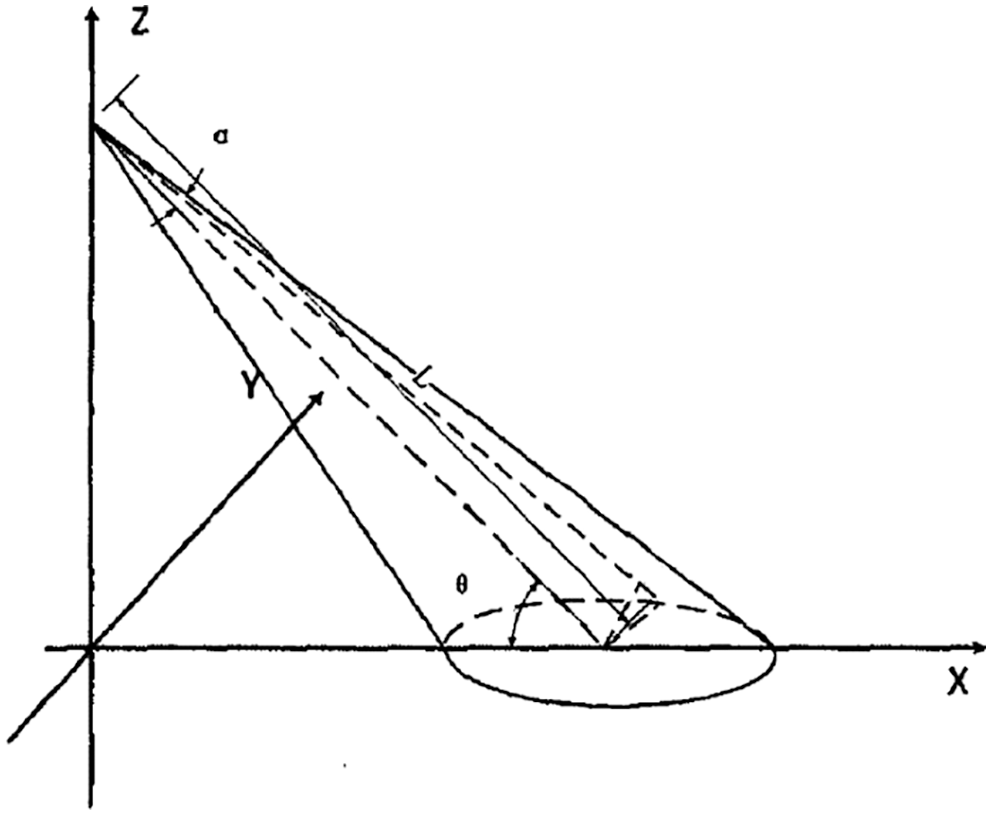
Figure 1: Schematic diagram of submerged inclined water jet scouring
According to the research of Dai [14], the surface equation of scouring surface is:
θ—Jet scour angle compensation
L—Distance from jet pole to sediment plane along jet direction
a—Jet expansion angle
The coupler-curve equation of contour outside scouring surface is:
According to Eq. (2), jet action surface area is s = f(L, θ);
The average force (P) of water jet hitting sediment surface in inclined jet:
According to Eq. (3), inclined jet scouring capacity is directly proportional to jet flow and nozzle outlet velocity as well as inclination angle.
3 Experimental Research on Submerged Inclined Water Jets
Scouring test system included test bench, control system and measurement system, as shown in Fig. 2.
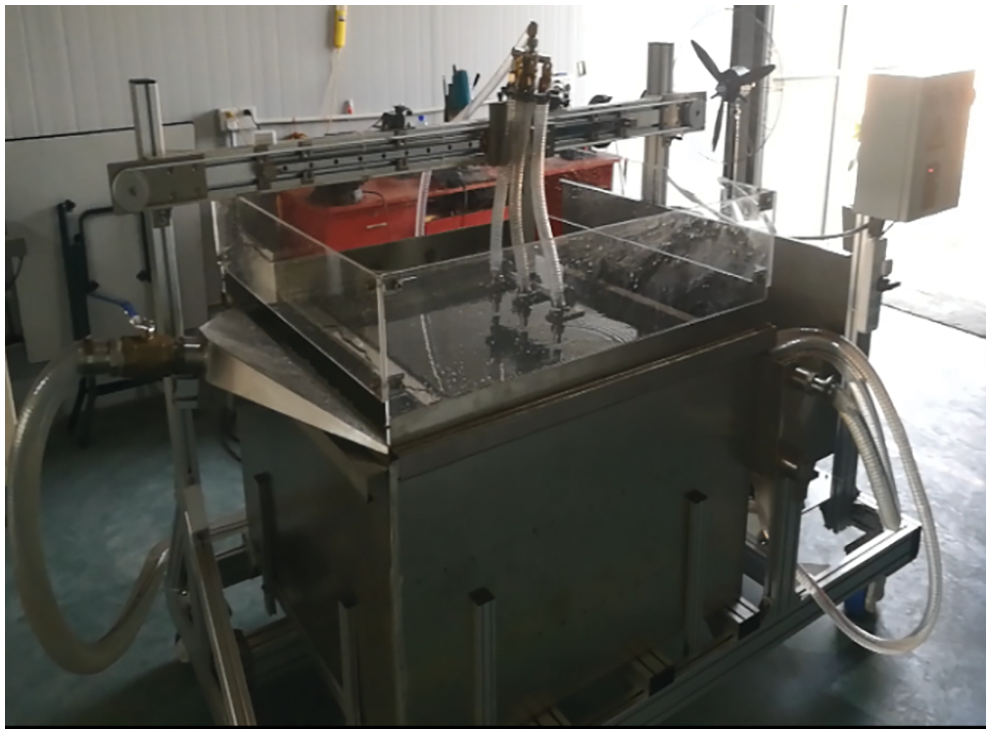
Figure 2: Scour test bench
Test bench included water tank, guide rail, nozzle mechanism, etc. Test water tank was 120 cm long, 100 cm wide and 100 cm high. A fixed guide rail was placed above water tank. Nozzle mechanism could move horizontally on slide rail via a speed regulating motor and nozzle height could adjust nozzle target distance through the movement of vertical slide block. Fig. 3 shows the schematic diagram of scouring test.
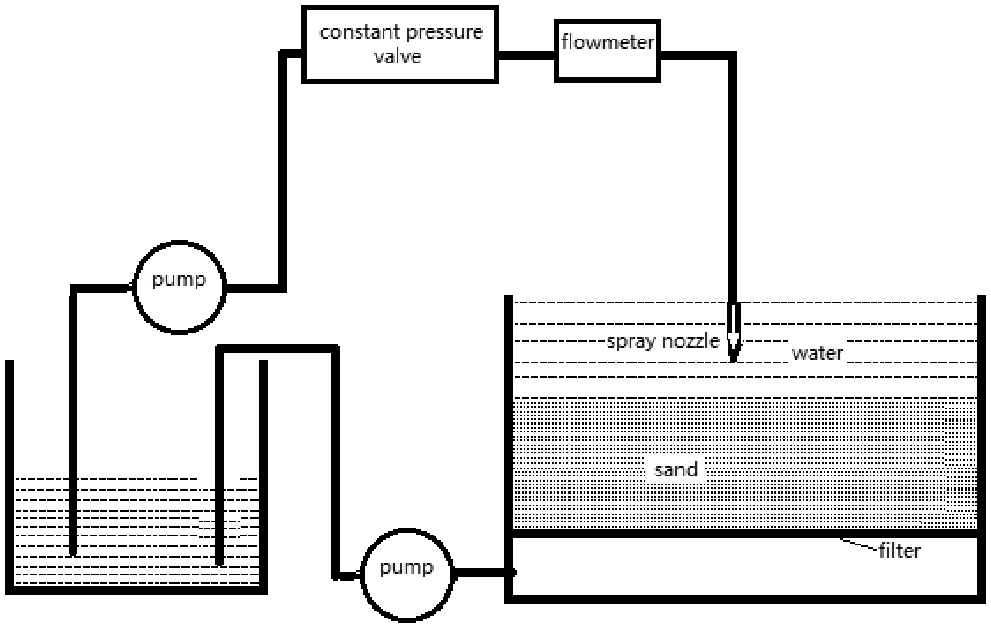
Figure 3: Schematic diagram of scouring test
Several experiments were conducted to quickly and repeatedly measure flushing pit contour without affecting flushing pit contour shape. In this work, a hollow filter (reinforced plate filter hole and steel filter screen) along with a spherical drain valve were installed at the bottom of sink. After performing scour tests, water could be quickly discharged from bottom drain valve without damaging scour pit contour. This made it possible to measure scour pit contour in time. In order to repeat submerged water jet tests, the device was equipped with overflow baffle and water collecting tank to realize water circulation.
Control system was mainly composed of variable displacement pump, circulating pump, variable frequency motor, flowmeter and control box to control nozzle movement and nozzle jet speed. Constant velocity of jet nozzle was controlled by flowmeter and constant pressure valve.
The success of experiments partly depended on operational procedures and partly on experimental data measurement. Researchers have developed many methods for scour pit experimental data measurement. Lei, Yan et al. adopted direct observation method to study the vertical scouring of sediments by plane submerged jets. They used wall attached jet and observed scour pit contour through transparent glass. However, based on the findings of Wenxin et al., the wall attached jet will affect the contour of the main jet scouring pit, when the jet swings disorderly in the later stage of scouring. Therefore, to prevent these effects on jet scouring process, 3D submerged jet has been applied to investigate scour pit in these tests. To do so, a simple and convenient measuring tool was designed which was consisted of (1) guide rail, (2) sliding block, (3) vertical adjusting arm (protractor and scale) and (4) angle adjusting arm, as shown in Fig. 4.
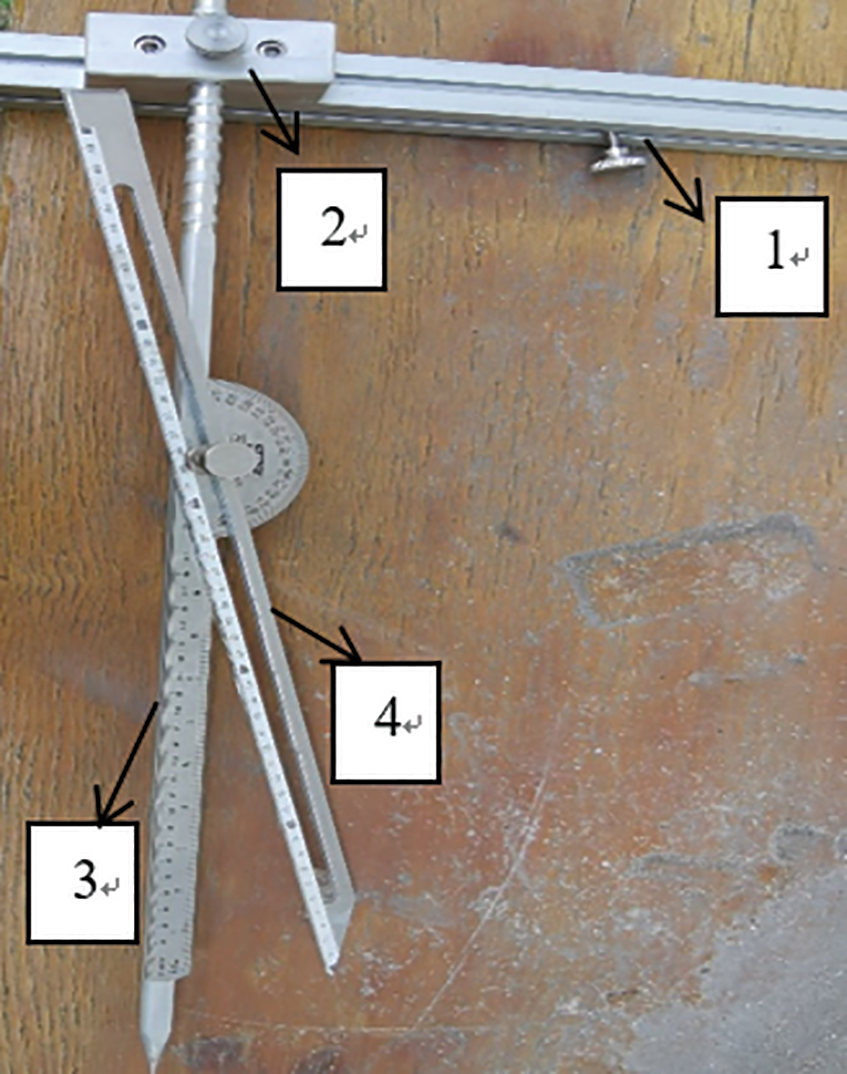
Figure 4: Measurement tool
The measurement tool was fixed on water tank through slide rail frame with vertical downward orientation and vertical adjusting arm tip touched the deepest part of scouring pit and its length was recorded (B in Fig. 5). Since scouring pit contour was axisymmetric, the length of angle adjusting arm (A) was constantly changed on the left and right sides of axial direction so that its tip touched scouring pit contour and α was the angle between A and B. According to the lengths of A and B, pit diameter and depth at different angles were calculated using triangular equations so as to obtain scouring pit contour section under different working conditions, as shown in Fig. 5.
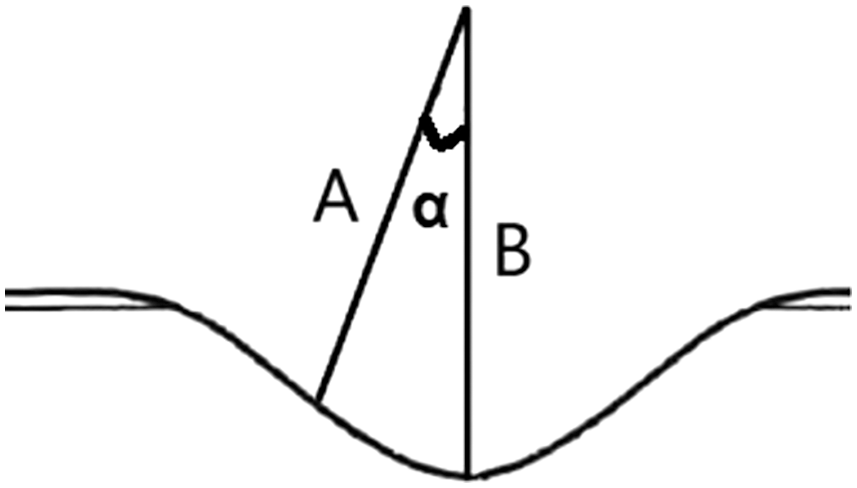
Figure 5: Schematic diagram of measurement mechanism
The search and salvage process usually requires careful deployment and long-time operation. The complex terrain and water flow conditions of the ocean, together with sediment uplift and redeposition due to the sinking of specific targets, result in a partial or complete sediment layer on the upper surfaces of targets. Therefore, in order to ensure a certain depth of scouring pit and safety of operation, selecting appropriate values for parameters such as jet angle and target distance for dredging operation is of critical significance. In this paper, the following parameters were adopted to investigate jet angle effect on scouring effect.
Specific parameters: based on subject requirements, scouring thickness needs to be more than 10 cm. According to the existing literature and software simulation results, jet injection angle was 0°∼30° and nozzle outlet speed was 3 m/s. This manuscript mainly studies the influence law of jet angle on scour under certain target distance, so the nozzle structure is poorly described. According to the existing research, when the target distance is 30∼35 times the nozzle diameter, the scouring efficiency is relative higher. Therefore, in order to facilitate processing, a cylindrical nozzle with a nozzle diameter of 0.3 cm and a length of 2.4 cm is selected.
Non-viscous and non-uniform sand particles (density 2650 kg/m3) were applied in this work and sand particles were analyzed by screening method. Analysis results are summarized in Table 1. Screening method had the advantages of simple equipment, convenient operation and intuitive measurement.

In ocean dredging, due to different sediment qualities and salvage depths which impose different confining pressures on jet, conducting relevant confining pressure simulation tests on land is very difficult. Therefore, based on submerged jet erosion tests at confining pressure of equal to 0, jet erosion under different confining pressures was numerically simulated.
Using above experimental devices and parameters, we measured scour pit parameters at inclination angles of 5°, 10°, 15°, 20° and 25°, and obtained 25 groups of scour pit contour data. We also analyzed the influences of inclination angle and scour time on scour pit contour. Test parameter values are summarized in Table 2.

The contour diagrams of scour pit under different scour times and jet angles are shown in Figs. 6–10. In practical applications, the efficiency of scour pit is only expressed by scour pit volume below sand bed plane. Since scour pit in this research was axisymmetric, its efficiency was stated by scour pit area below sand bed plane when y in Figs. 6–10 was less than 0. The values of these areas are shown in Fig. 11.

Figure 6: Scouring diagram with inclination of 5°
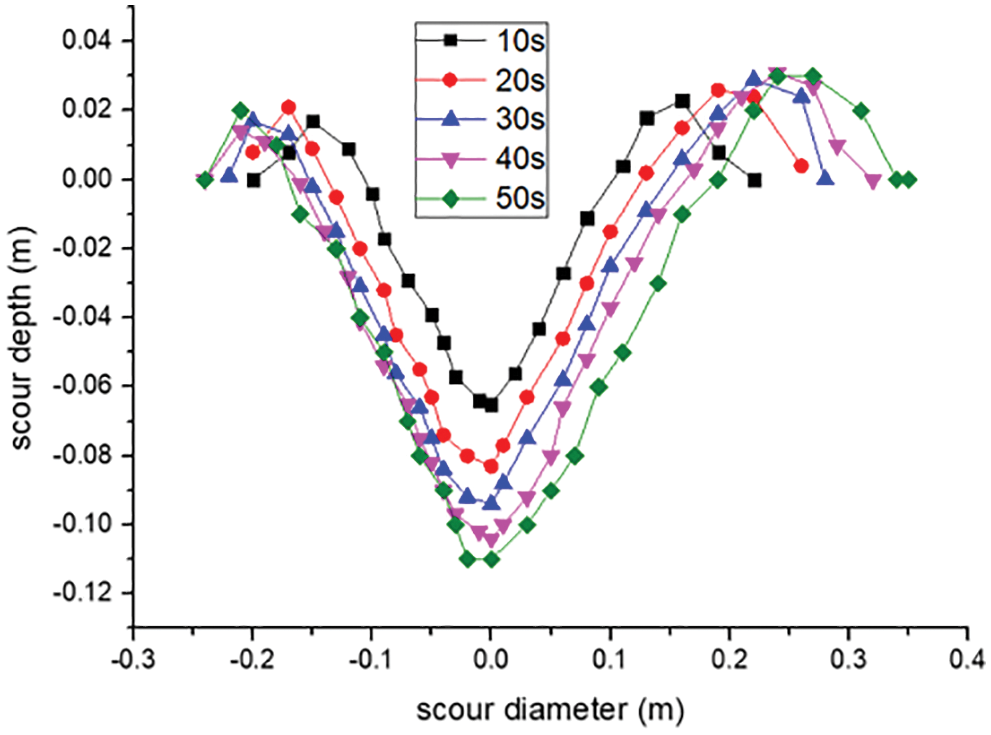
Figure 7: Scouring diagram with inclination of 10°

Figure 8: Scouring diagram with inclination of 15°
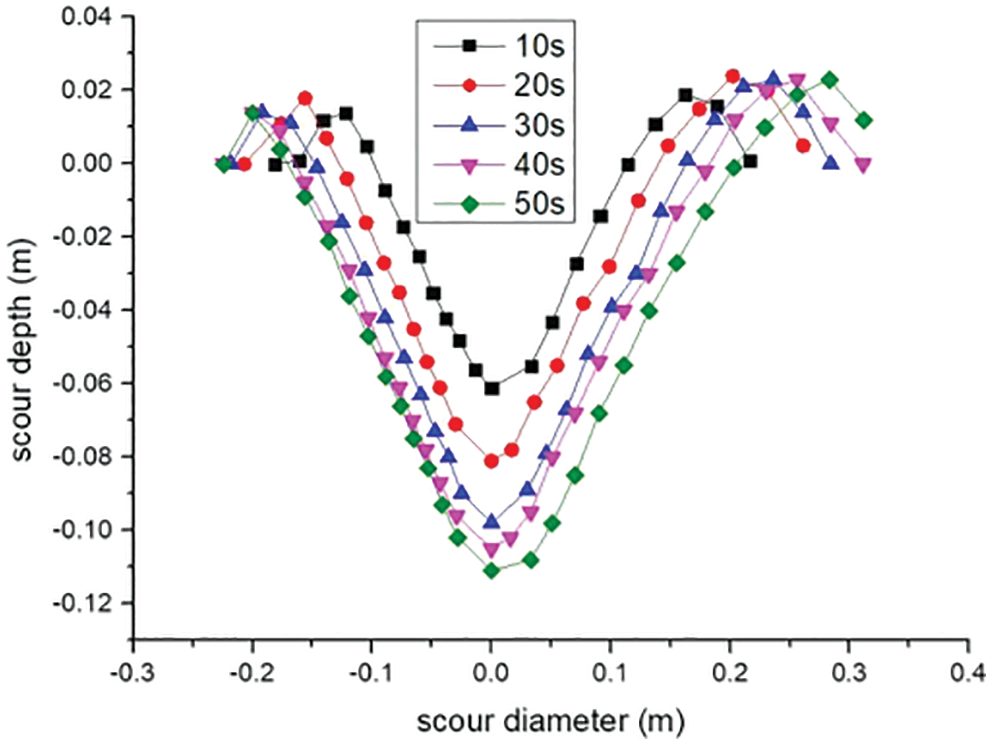
Figure 9: Scouring diagram with inclination of 20°
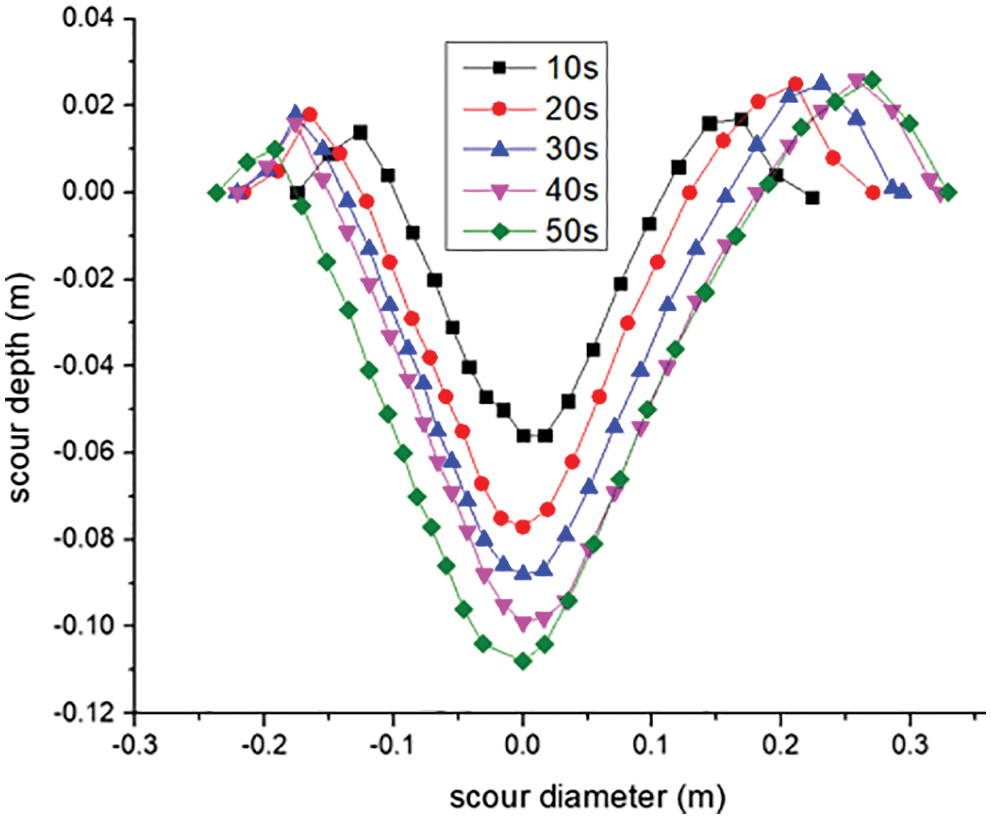
Figure 10: Scouring diagram at inclination angle of 25°
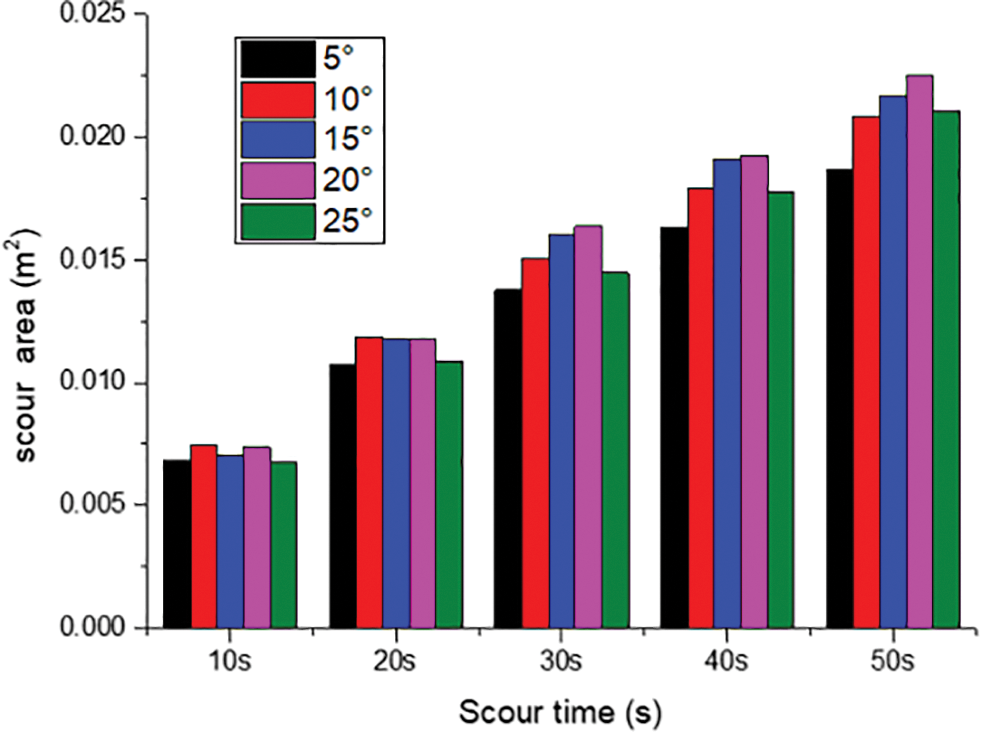
Figure 11: Scour pit area at different times and angles
From the above scouring results, it was seen that the depth and width of scouring pit were proportionally changed with time at constant jet velocity and target distance. For example, from 10 to 30 s, the depth and width of scouring pits with different inclination angles were increased sharply, while increase rate was slower after 40 s. According to experimental data, during the same period, at inclination angles of 20° and 15°, scouring pit depth was higher, while those at inclination angles of 5°and 25° were smaller.
As was seen from Fig. 6, after scouring for 10 s, a small sand dune was formed at the interface of jet center and scouring pit. Due to small inclination angle and scouring pit depth, the directions of incident velocity and reflection velocity were almost opposite and on both sides, water flow moved along sand/water interface to form a vortex. Consequently, scour pit at jet center was higher than that on either side. However, as time passed, scour pit depth continued to increase, amplifying the influence of inclination angle, which in turn resulted in the formation of the deepest scour pit at jet center.
It was seen from Fig. 11 that with the increase of scouring time, scouring areas for inclination angles of 20° and 15° were also increased, while scouring area was decreased with the increase of inclination angle. In other words, scouring efficiency was the highest in inclination angle range of 15°∼20°.
25 groups of tests were conducted under certain test conditions. According to the obtained test results, the following conclusions were drawn:
(1) In this test, jets with inclination angles of 20° and 15° had the largest scouring area, while the smallest scouring area was obtained at inclination angle of 25°. Therefore, it was seen that in the relevant scouring process, the inclination angles with the highest scouring pit efficiencies were in the range of 15°∼20°.
(2) According to subject requirements, scouring time of up to about 40 s was needed to reach the scouring pit depth of more than 10 cm. After 40 s, scour pit depth change rate began to slow down.
(3) Within the test range, scouring volume was increased with the increase of scouring time, but the increasing rate was lower. It could be predicted that after 50 s of scouring, scouring volume would gradually reach its maximum value and remain unchanged; that is, dynamic equilibrium state was reached.
(4) Based on the found rules and requirements of the research, the jets with inclination angles of 15°∼20° were selected for this study and jetting time was about 40 s, which met research needs and laid a foundation for subsequent research.
In the current work, only the mechanism of water jet erosion in submerged environments was studied. Then, corresponding numerical models will be continuously optimized and verified according to the findings of this research. On this basis, the mechanism of water jet scouring the seabed in deep-sea environments will be studied by numerical simulations in the future.
Funding Statement: The paper was supported by National Nature Fund of China (52071091) and the Key Laboratory of Expressway Construction Machinery of Shanxi Province which is gained by Zhang (300102259512).
Conflicts of Interest: The authors declare that they have no conflicts of interest to report regarding the present study.
1. Ortega-Casanova, J., Campos, N., Ramon Fernandez-Feria, R. (2007). Experimental study on sand bed excavation by impinging swirling jets. Journal of Hydraulic Research, 49(5), 601–610. DOI 10.1080/00221686.2011.593346. [Google Scholar] [CrossRef]
2. Chakravarti, A., Jain, R. K., Kothyari, U. C. (2014). Scour under submerged circular vertical jets in cohesionless sediments. ISH Journal of Hydraulic Engineering, 20(1), 32–37. DOI 10.1080/09715010.2013.835101. [Google Scholar] [CrossRef]
3. Mazurek, K. A., Hossain, T. (2011). Scour by jets in cohesionless and cohesive soils. Canadian Journal of Civil Engineering, 34(6), 744–751. DOI 10.1139/l07-005. [Google Scholar] [CrossRef]
4. Rajaratnam, N., Beltaos, S. (1977). Erosion by impinging circular turbulent jets. Journal of the Hydraulics Division, 103(10), 1191–1205. DOI 10.1061/JYCEAJ.0004852. [Google Scholar] [CrossRef]
5. Aderibigbe, O. O., Rajaratnam, N. (1996). Erosion of loose beds by submerged circular impinging vertical turbulent jets. Journal of Hydraulic Research, 34(1), 19–33. DOI 10.1080/00221689609498762. [Google Scholar] [CrossRef]
6. Mih, W. C., Kabir, J. (1983). Impingement of water jets on non-uniform stream bed. Journal of Hydraulic Engineering, 109(4), 536–548. DOI 10.1061/(ASCE)0733-9429(1983)109:4(536). [Google Scholar] [CrossRef]
7. Taştan, K., Koçak, P., Yildirim, N. (2016). Effect of the bed-sediment layer on the scour caused by a jet. Arabian Journal for Science and Engineering, (10), 1–9. DOI 10.1007/s13369-016-2093-7. [Google Scholar] [CrossRef]
8. Beltaos, S., Rajaratnam, N. (2010). Impingement of axisymmetric developing jets. Journal of Hydraulic Research, 15(4), 55–59. DOI 10.1080/00221687709499637. [Google Scholar] [CrossRef]
9. Aderibigbe, O. O., Rajaratnam, N. (2010). Erosion of loose beds by submerged circular impinging vertical turbulent jets. Journal of Hydraulic Research, 34(1), 96–100. DOI 10.1080/00221689609498762. [Google Scholar] [CrossRef]
10. Qi, M. L., Fu, R. S., Chen, Z. C. (2005). Study on equilibrium depth of jet erosion. Hydrodynamic Research and Progress, 20(3), 368–372. DOI 10.3969/j.issn.1000-4874.2005.03.014. [Google Scholar] [CrossRef]
11. Huai, W. X., Wang, Z. W., Qian, Z. D. (2012). Numerical simulation of two-dimensional vertical jet scouring on sandy riverbed. Science China Technological Science, 1, 72–81. [Google Scholar]
12. Gu, L., Ni, F. S., Xv, L. Q. (2017). Experimental study on nozzle spacing of vertical jet scouring sand bed. Sediment Research, 42(3), 54–58. DOI 10.16239/j.cnki.0468-155x.2017.03.010. [Google Scholar] [CrossRef]
13. Qian, Z. D., Hu, X. Q. (2011). Numerical simulation of submerged jet erosion based on Euler model. Science China Technological Science, 41(4), 419–425. DOI 10.1088/0253-6102/55/2/31. [Google Scholar] [CrossRef]
14. Dai, B. L. (2016). Research on the jetting arm of jetting propelled ROV trencher and its jetting process. Hangzhou: Zhejiang University. [Google Scholar]
 | This work is licensed under a Creative Commons Attribution 4.0 International License, which permits unrestricted use, distribution, and reproduction in any medium, provided the original work is properly cited. |